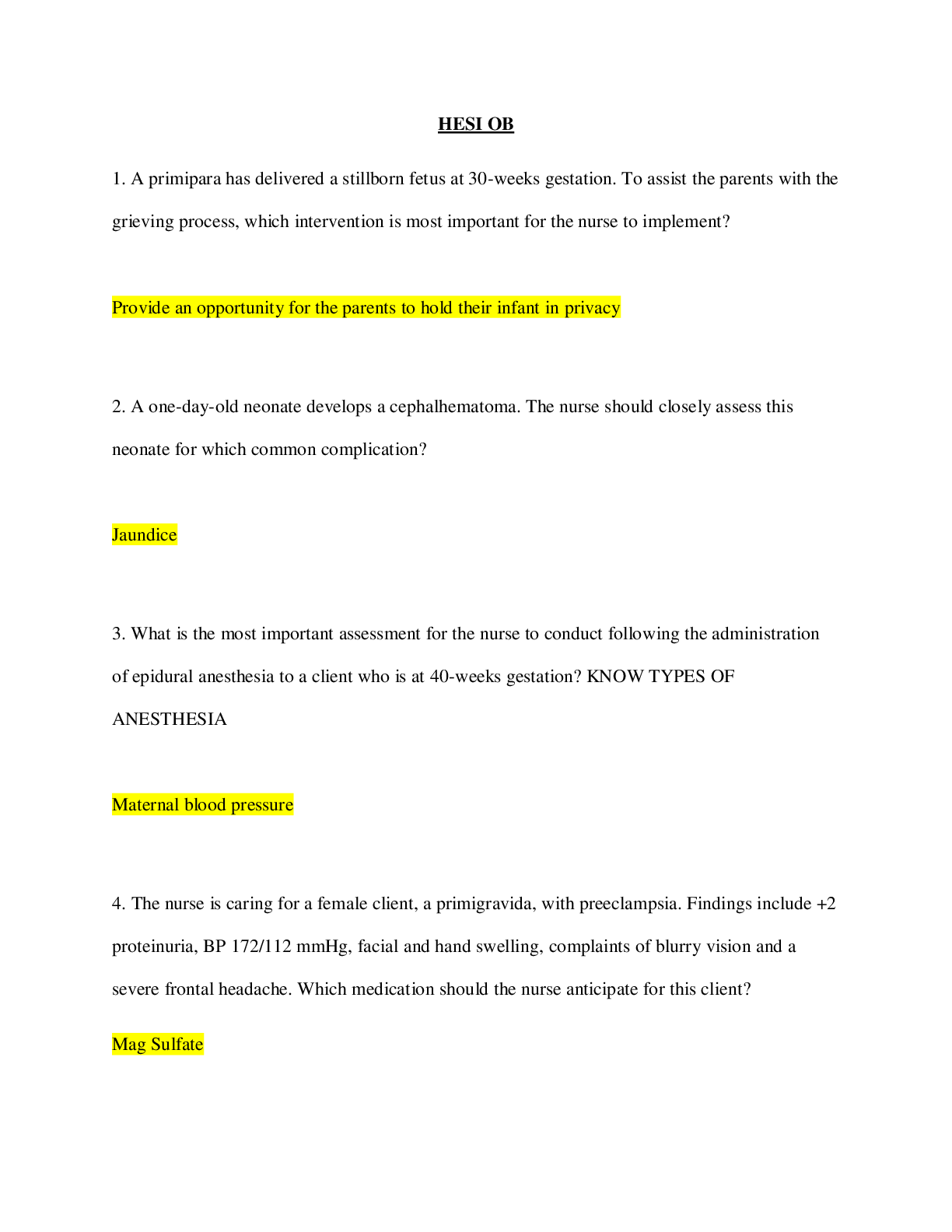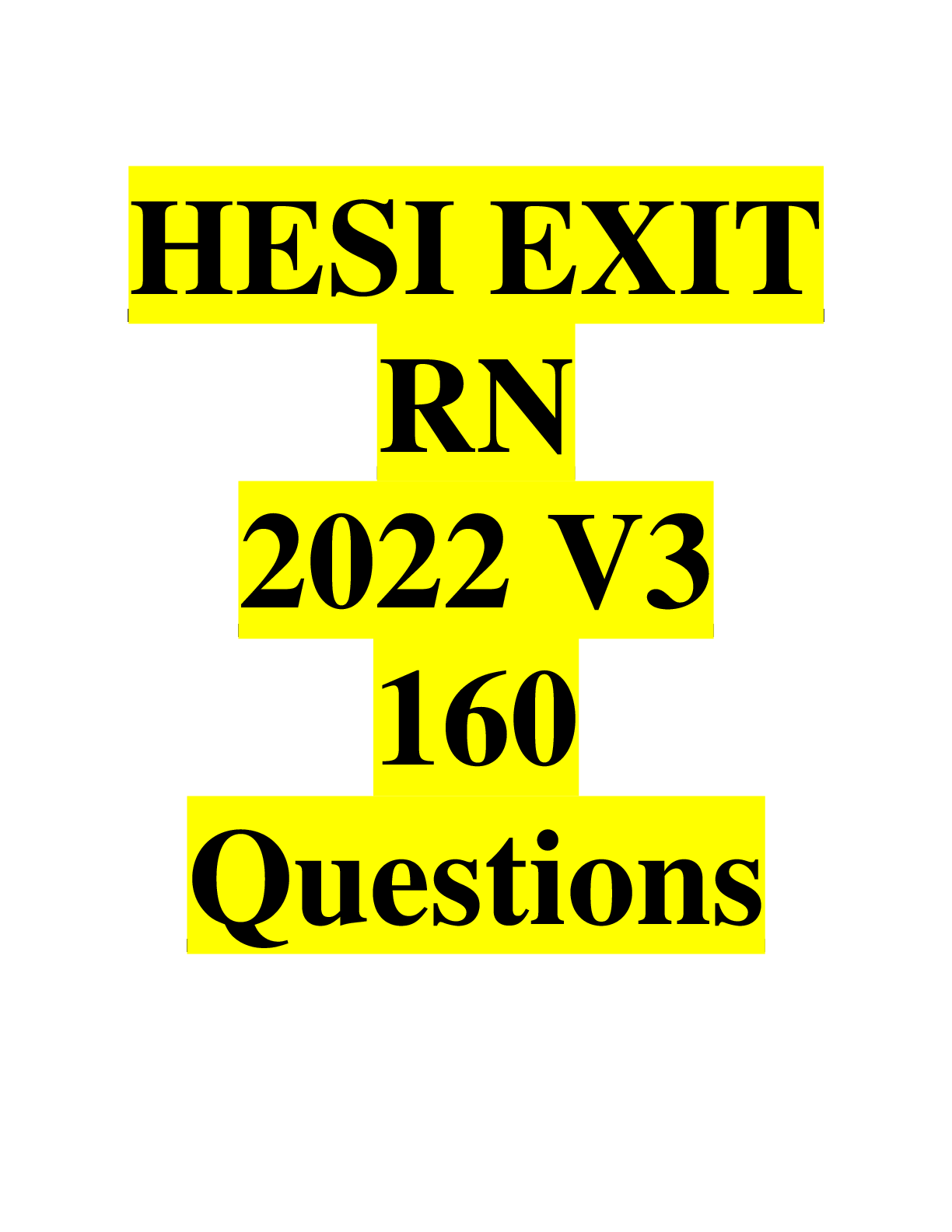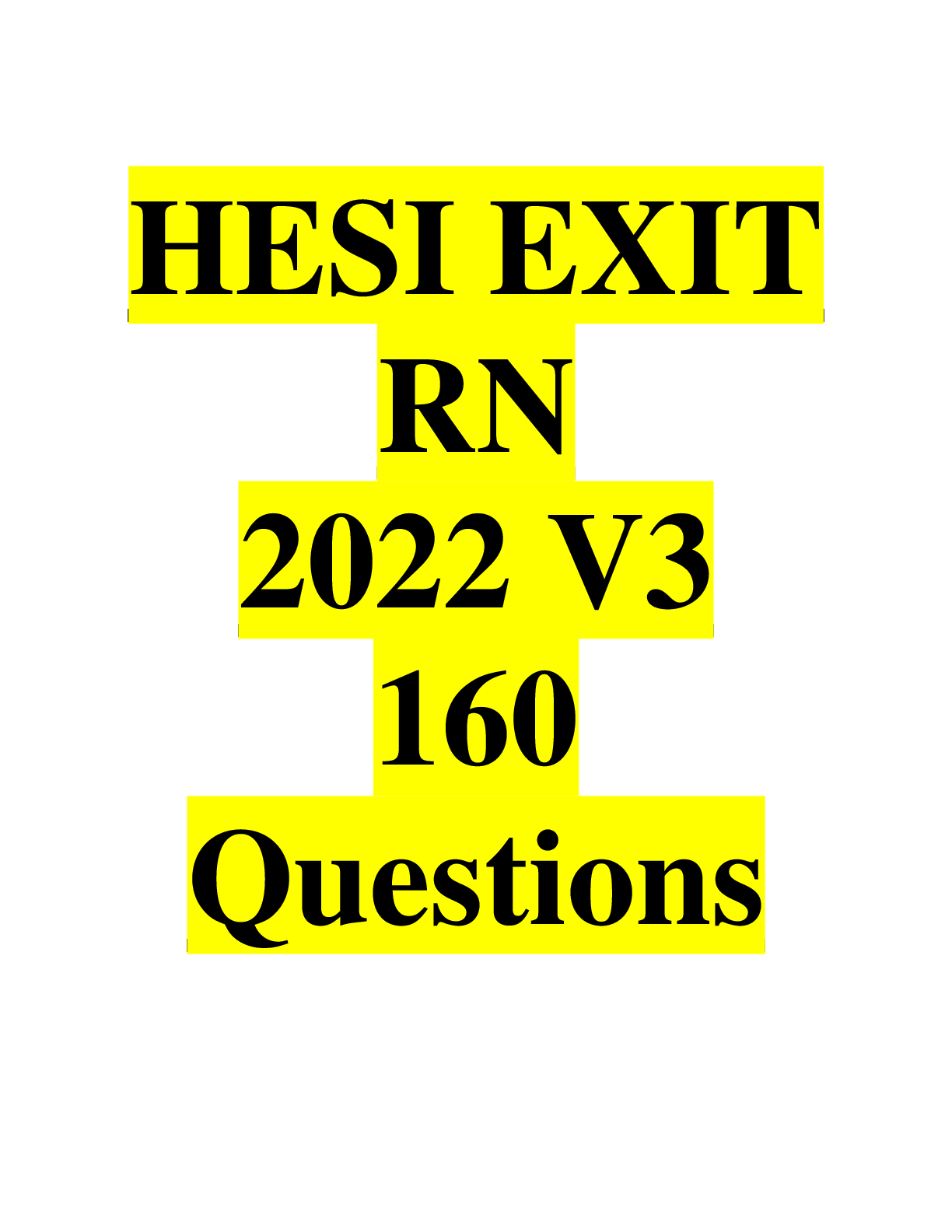*NURSING > HESI > HESI PN EXIT EXAM V3 110 QUESTIONS AND ANSWER(S) UPDATED WITH THE CORRECT ANSWERS HIGHLIGHTED. (All)
HESI PN EXIT EXAM V3 110 QUESTIONS AND ANSWER(S) UPDATED WITH THE CORRECT ANSWERS HIGHLIGHTED.
Document Content and Description Below
HESI PN EXIT EXAM V3 110 QUESTIONS AND ANSWER(S) 1. An adult client experiences a gasoline tank fire when riding a motorcycle and is admitted to the emergency department (ED) with full thickness bu... rns to all surfaces of both lower extremities. What percentage of body surface area should the nurse document in the electronic medical record (EMR)? 9 % 18 % 36 % 45 % Rational: according to the rule of nines, the anterior and posterior surfaces of one lower extremity is designated as 18 %of total body surface area (TBSA), so both extremities equals 36% TBSA, other options are incorrect. 2. A client with hyperthyroidism is receiving propranolol (Inderal). Which finding indicates that the medication is having the desired effect? Decrease in serum T4 levels Increase in blood pressure Decrease in pulse rate Goiter no longer palpable 3. An older male client with type 2 diabetes mellitus reports that has experiences legs pain when walking short distances, and that the pain is relieved by rest. Which client behavior indicates an understanding of healthcare teaching to promote more effective arterial circulation? Consistently applies TED hose before getting dressed in the morning. Frequently elevated legs thorough the day. Inspect the leg frequently for any irritation or skin breakdown Completely stop cigarette/ cigar smoking. Rationale: Stopping cigarette smoking helps to decrease vasoconstriction and improve arterial circulation to the extremity. 4. A community health nurse is concerned about the spread of communicable diseases among migrant farm workers in a rural community. What action should the nurse take to promote the success of a healthcare program designed to address this problem? Establish trust with community leaders and respect cultural and family values 5. The nurse performs a prescribed neurological check at the beginning of the shift on a client who was admitted to the hospital with a subarachnoid brain attack (stroke). The client’s Glasgow Coma Scale (GCS) score is 9. What information is most important for the nurse to determine? The client’s previous GCS score When the client’s stroke symptoms started If the client is oriented to time The client’s blood pressure and respiration rate Rationale: The normal GCS is 15, and it is most important for the nurse to determine if it abnormal score a sign of improvement or a deterioration in the client’s condition 6. The charge nurse in a critical care unit is reviewing clients’ conditions to determine who is stable enough to be transferred. Which client status report indicates readiness for transfer from the critical care unit to a medical unit? Chronic liver failure with a hemoglobin of 10.1 and slight bilirubin elevation 7. Based on principles of asepsis, the nurse should consider which circumstance to be sterile? One inch- border around the edge of the sterile field set up in the operating room A wrapped unopened, sterile 4x4 gauze placed on a damp table top. An open sterile Foley catheter kit set up on a table at the nurse waist level Sterile syringe is placed on sterile area as the nurse riches over the sterile field. Rationale: A sterile package at or above the waist level is considered sterile. The edge of sterile field is contaminated which include a 1-inch border (A). A sterile objects become contaminated by capillary action when sterile objects become in contact with a wet contaminated surface. 8. An unlicensed assistive personnel (UAP) reports that a client’s right hand and fingers spasms when taking the blood pressure using the same arm. After confirming the presence of spams what action should the nurse take? Ask the UAP to take the blood pressure in the other arm Tell the UAP to use a different sphygmomanometer. Review the client’s serum calcium level Administer PRN antianxiety medication. Rationale: Trousseau’s sign is indicated by spasms in the distal portion of an extremity that is being used to measure blood pressure and is caused by hypocalcemia (normal level 9.0-10.5 mg/dl, so C should be implemented. 9. A 56-years-old man shares with the nurse that he is having difficulty making decision about terminating life support for his wife. What is the best initial action by the nurse? Provide an opportunity for him to clarify his values related to the decision Encourage him to share memories about his life with his wife and family Advise him to seek several opinions before making decision Offer to contact the hospital chaplain or social worker to offer support. Rationale: When a client is faced with a decisional conflict, the nurse should first provide opportunities for the client to clarify values important in the decision. The rest may also be beneficial once the client as clarified the values that are important to him in the decision-making process. 10. A client is being discharged home after being treated for heart failure (HF). What instruction should the nurse include in this client’s discharge teaching plan? Weigh every morning Eat a high protein diet Perform range of motion exercises Limit fluid intake to 1,500 ml daily 11. A woman just learned that she was infected with Heliobacter pylori. Based on this finding, which health promotion practice should the nurse suggest? Encourage screening for a peptic ulcer 12. A client who recently underwear a tracheostomy is being prepared for discharge to home. Which instructions is most important for the nurse to include in the discharge plan? Teach tracheal suctioning techniques 13. A child with heart failure is receiving the diuretic furosemide (Lasix) and has serum potassium level 3.0 mEq/L. Which assessment is most important for the nurse to obtain? Cardiac rhythm and heart rate. Daily intake of foods rich in potassium. Hourly urinary output Thirst ad skin turgor. 14. The nurse note a depressed female client has been more withdrawn and non-communicative during the past two weeks. Which intervention is most important to include in the updated plan of care for this client? Encourage the client’s family to visit more often Schedule a daily conference with the social worker Encourage the client to participate in group activities Engage the client in a non-threatening conversation. Rationale: Consistent attempts to draw the client into conversations which focus on non-threatening subjects can be an effective means of eliciting a response, thereby decreasing isolation behaviors. There is not sufficient data to support the effectiveness of A as an intervention for this client. Although B may be indicated, nursing interventions can also be used to treat this client. C is too threatening to this client. 15. A client with rheumatoid arthritis (RA) starts a new prescription of etanercept (Enbrel) subcutaneously once weekly. The nurse should emphasize the importance of reporting problem to the healthcare provider? Headache Joint stiffness Persistent fever Increase hunger and thirst Rationale: Enbrel decrease immune and inflammatory responses, increasing the client’s risk of serious infection, so the client should be instructed to report a persistent fever, or other signs of infection to the healthcare provider. 16. The nurse is assessing an older adult with type 2 diabetes mellitus. Which assessment finding indicates that the client understands long- term control of diabetes? The fating blood sugar was 120 mg/dl this morning. Urine ketones have been negative for the past 6 months The hemoglobin A1C was 6.5g/100 ml last week No diabetic ketoacidosis has occurred in 6 months. Rationale: A hemoglobin A1C level reflects he average blood sugar the client had over the previous 2 to 3 month, and level of 6.5 g/100 ml suggest that the client understand long-term diabetes control. Normal value in a diabetic patient is up to 6.5 g/100 ml. 17. An older male client is admitted with the medical diagnosis of possible cerebral vascular accident (CVA). He has facial paralysis and cannot move his left side. When entering the room, the nurse finds the client’s wife tearful and trying unsuccessfully to give him a drink of water. What action should the nurse take? Ask the wife to stop and assess the client’s swallowing reflex 18. A 13 years-old client with non-union of a comminuted fracture of the tibia is admitted with osteomyelitis. The healthcare provider collects home aspirate specimens for culture and sensitivity and applies a cast to the adolescent’s lower leg. What action should the nurse implement next? Administer antiemetic agents Bivalve the cast for distal compromise Provide high- calorie, high-protein diet Begin parenteral antibiotic therapy Rationale: The standard of treatment for osteomyelitis is antibiotic therapy and immobilization. After bond and blood aspirate specimens are obtained for culture and sensitivity, the nurse should initiate parenteral antibiotics as prescribed. 19. The nurse is preparing a community education program on osteoporosis. Which instruction is helpful in preventing bone loss and promoting bone formation? Recommend weigh bearing physical activity 20. A client with a history of chronic pain requests a nonopioid analgesic. The client is alert but has difficulty describing the exact nature and location of the pain to the nurse. What action should the nurse implement next? Administer the analgesic as requested 21. A male client receives a thrombolytic medication following a myocardial infarction. When the client has a bowel movement, what action should the nurse implement? Send stool sample to the lab for a guaiac test Observe stool for a day-colored appearance. Obtain specimen for culture and sensitivity analysis Asses for fatty yellow streaks in the client’s stool. Rationale: Thrombolytic drugs increase the tendency for bleeding. So guaiac (occult blood test) test of the stool should be evaluated to detect bleeding in the intestinal tract. 22. The mother of a child with cerebral palsy (CP) ask the nurse if her child’s impaired movements will worsen as the child grows. Which response provides the best explanation? Brain damage with CP is not progressive but does have a variable course 23. During shift report, the central electrocardiogram (EKG) monitoring system alarms. Which client alarm should the nurse investigate first? Respiratory apnea of 30 seconds 24. In early septic shock states, what is the primary cause of hypotension? Peripheral vasoconstriction Peripheral vasodilation Cardiac failure A vagal response Rationale: Toxins released by bacteria in septic shock create massive peripheral vasodilation and increase microvascular permeability at the site of the bacterial invasion. 25. A client diagnosed with calcium kidney stones has a history of gout. A new prescription for aluminum hydroxide (Amphogel) is scheduled to begin at 0730. Which client medication should the nurse bring to the healthcare provider’s attention? Allopurinol (Zyloprim) Aspirin, low dose Furosemide (lasix) Enalapril (vasote) 26. A male client’s laboratory results include a platelet count of 105,000/ mm3 Based on this finding the nurse should include which action in the client’s plan of care? Cluster care to conserve energy Initiate contact isolation Encourage him to use an electric razor Asses him for adventitious lung sounds Rationale: This client is at risk for bleeding based on his platelet count (normal 150,000 to 400,000/ mm3). Safe practices, such as using an electric razor for shaving, should be encouraged to reduce the risk of bleeding. 27. A client is admitted to the hospital after experiencing a brain attack, commonly referred to as a stroke or cerebral vascular accident (CVA). The nurse should request a referral for speech therapy if the client exhibits which finding? Abnormal responses for cranial nerves I and II Persistent coughing while drinking Unilateral facial drooping Inappropriate or exaggerated mood swings 28. At 1615, prior to ambulating a postoperative client for the first time, the nurse reviews the client’s medical record. Based on date contained in the record, what action should the nurse take before assisting the client with ambulation: Remove sequential compression devices. Apply PRN oxygen per nasal cannula. Administer a PRN dose of an antipyretic. Reinforce the surgical wound dressing. Rationale: Sequential compression devices should be removed prior to ambulation and there is no indication that this action is contraindicated. The client’s oxygen saturation levels have been within normal limits for the previous four hours, so supplemental oxygen is not warranted. [Show More]
Last updated: 8 months ago
Preview 1 out of 28 pages

Reviews( 0 )
Document information
Connected school, study & course
About the document
Uploaded On
May 15, 2022
Number of pages
28
Written in
Additional information
This document has been written for:
Uploaded
May 15, 2022
Downloads
5
Views
544

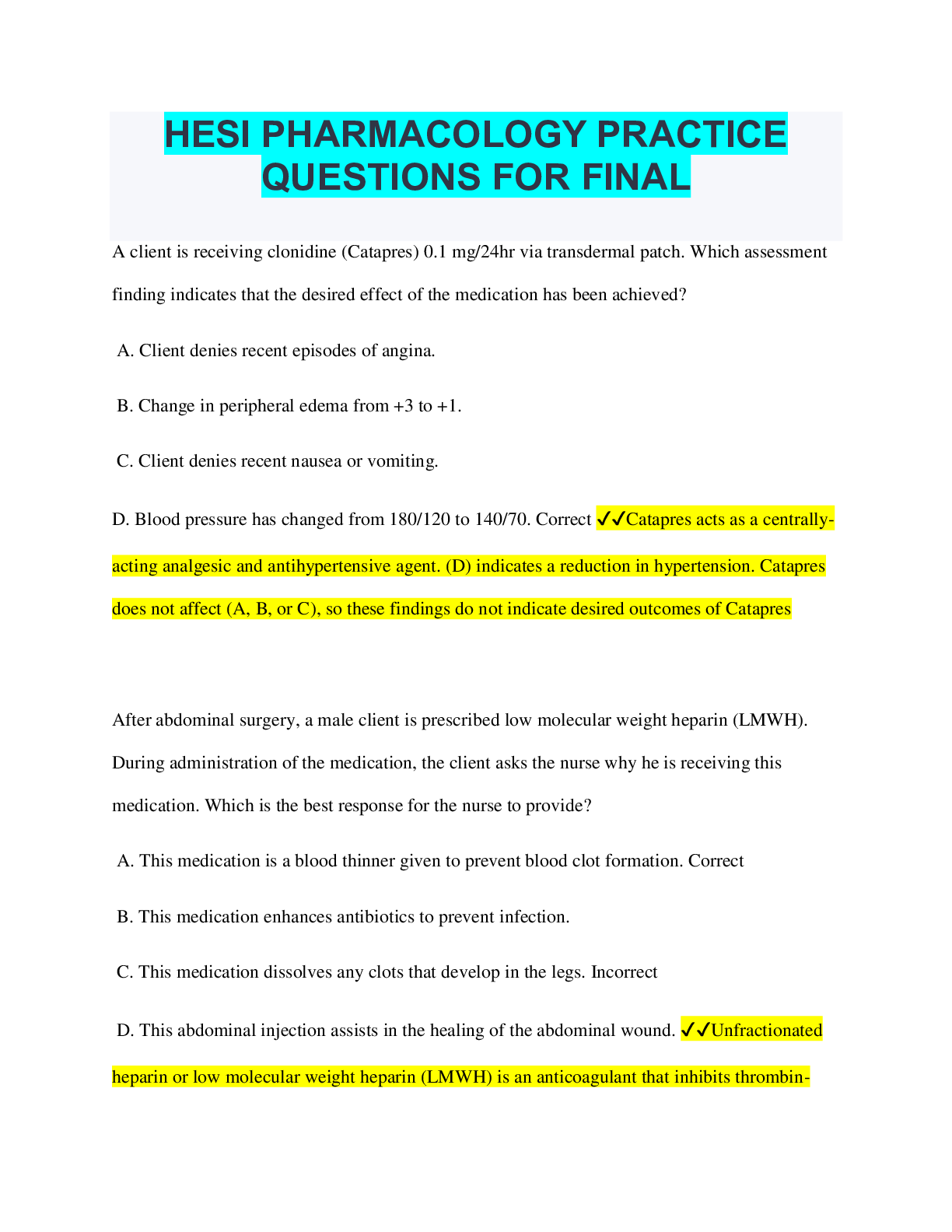
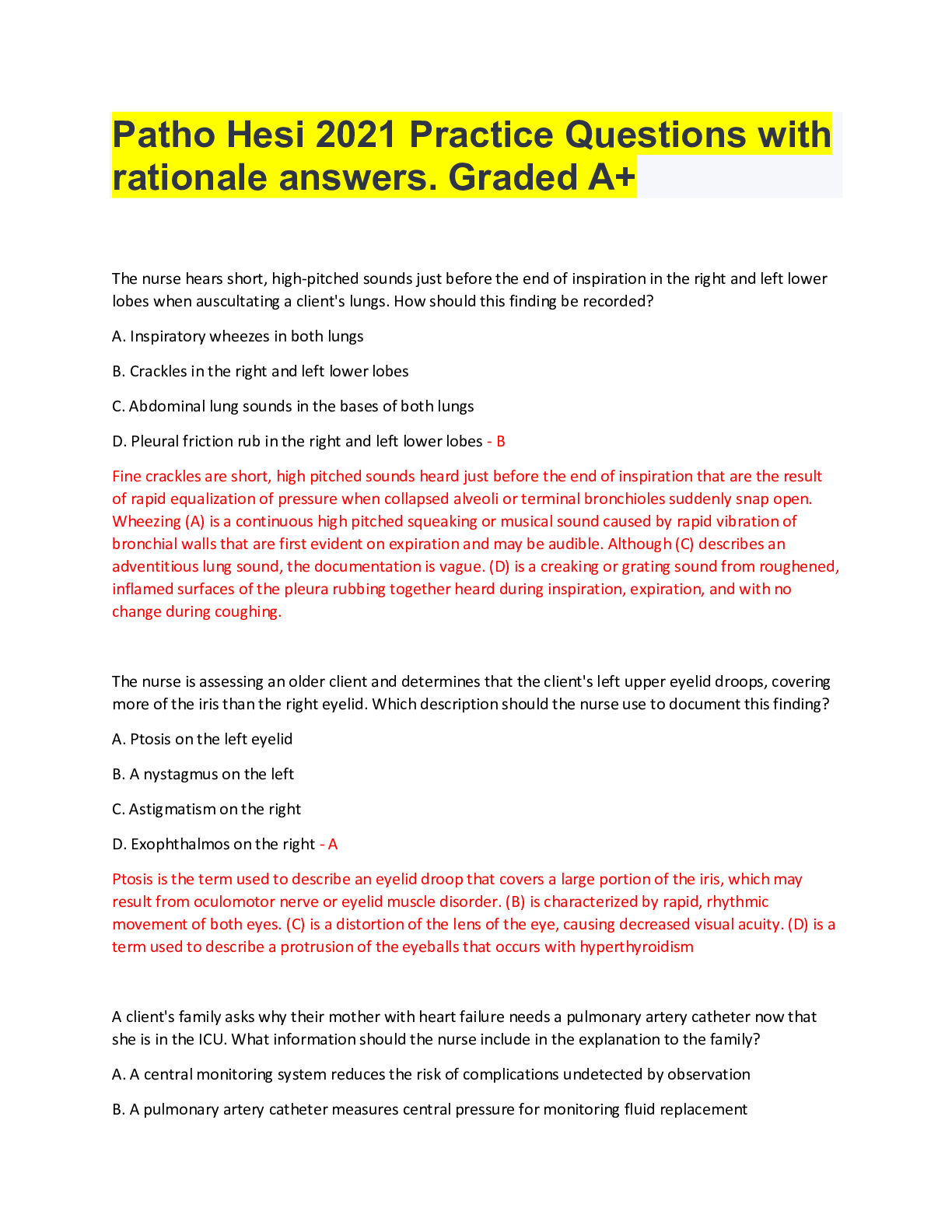
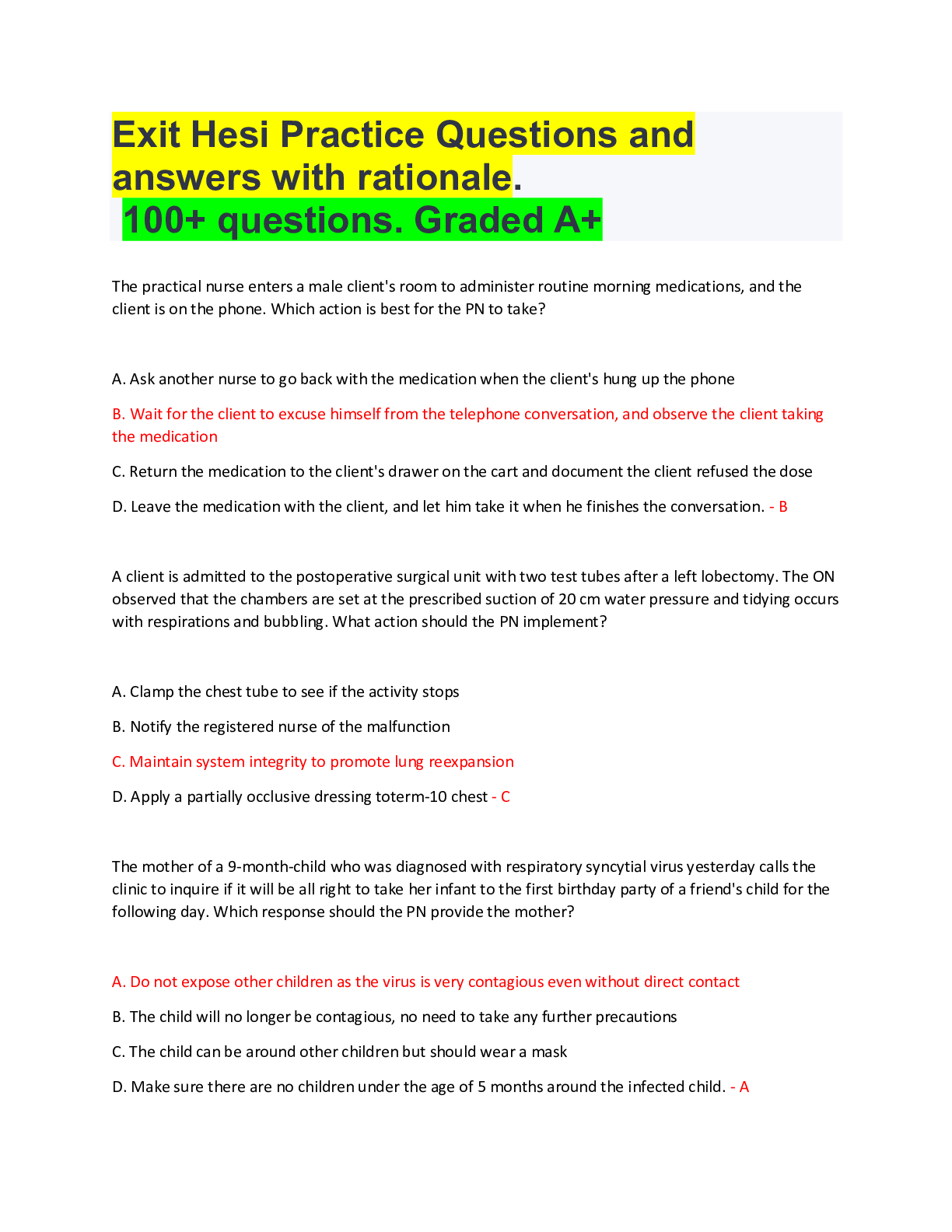
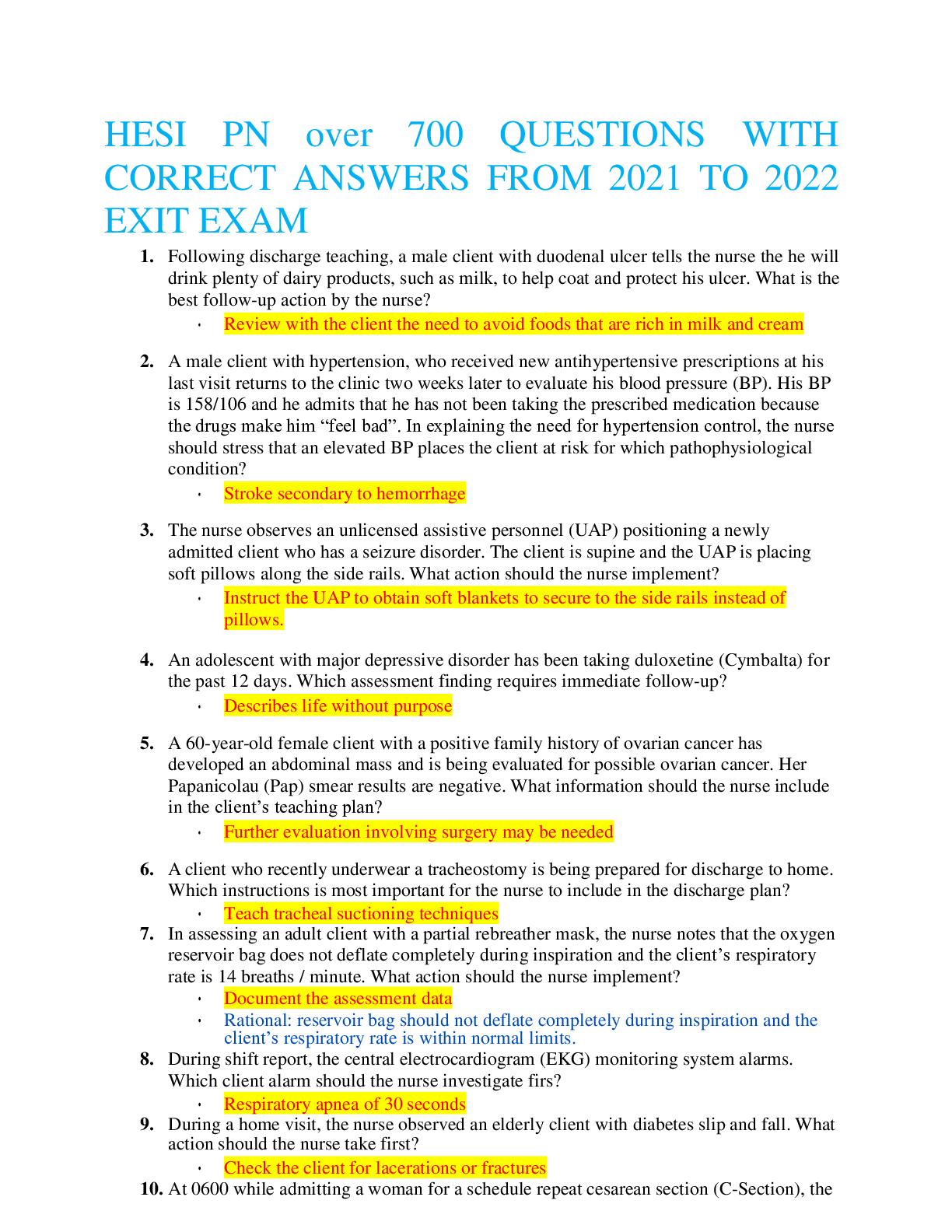
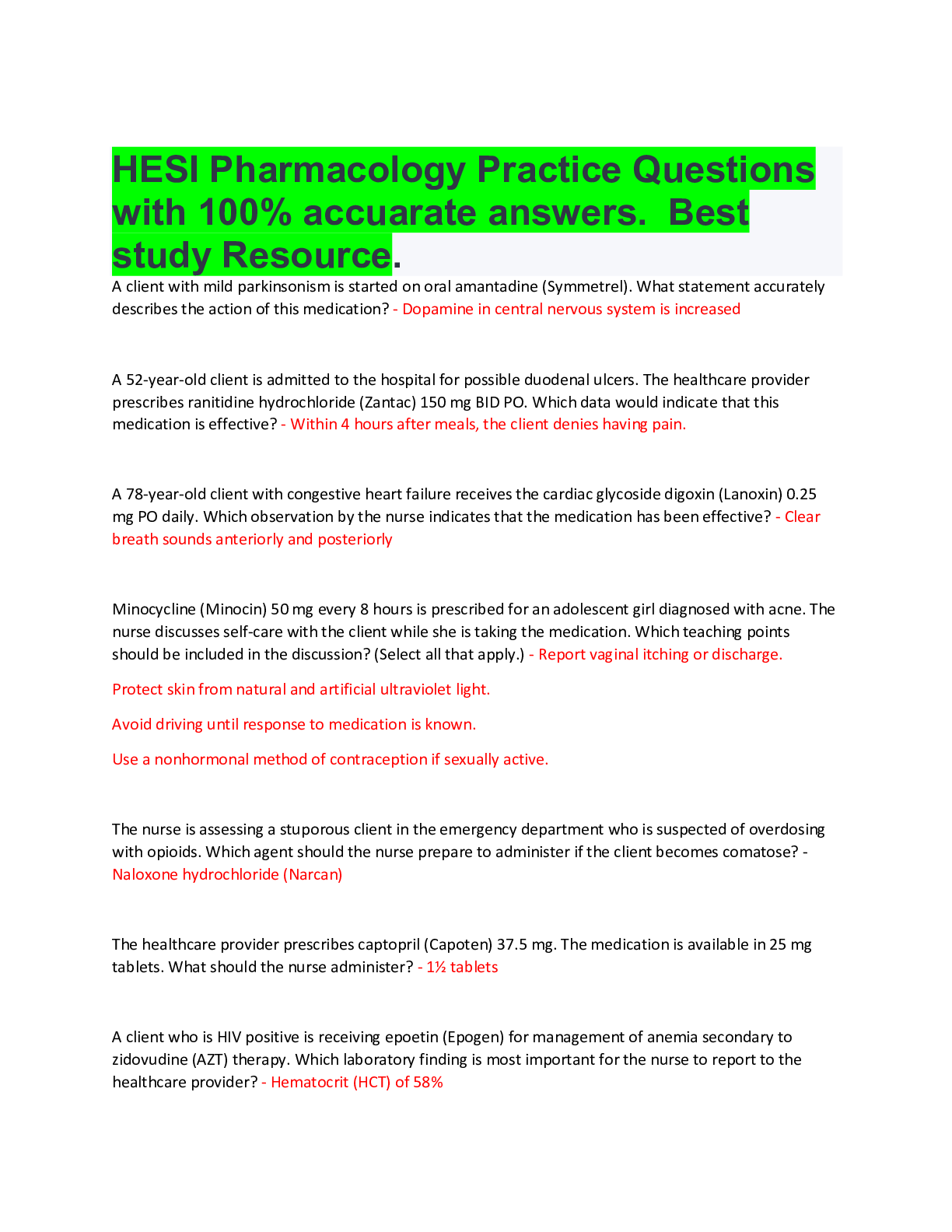

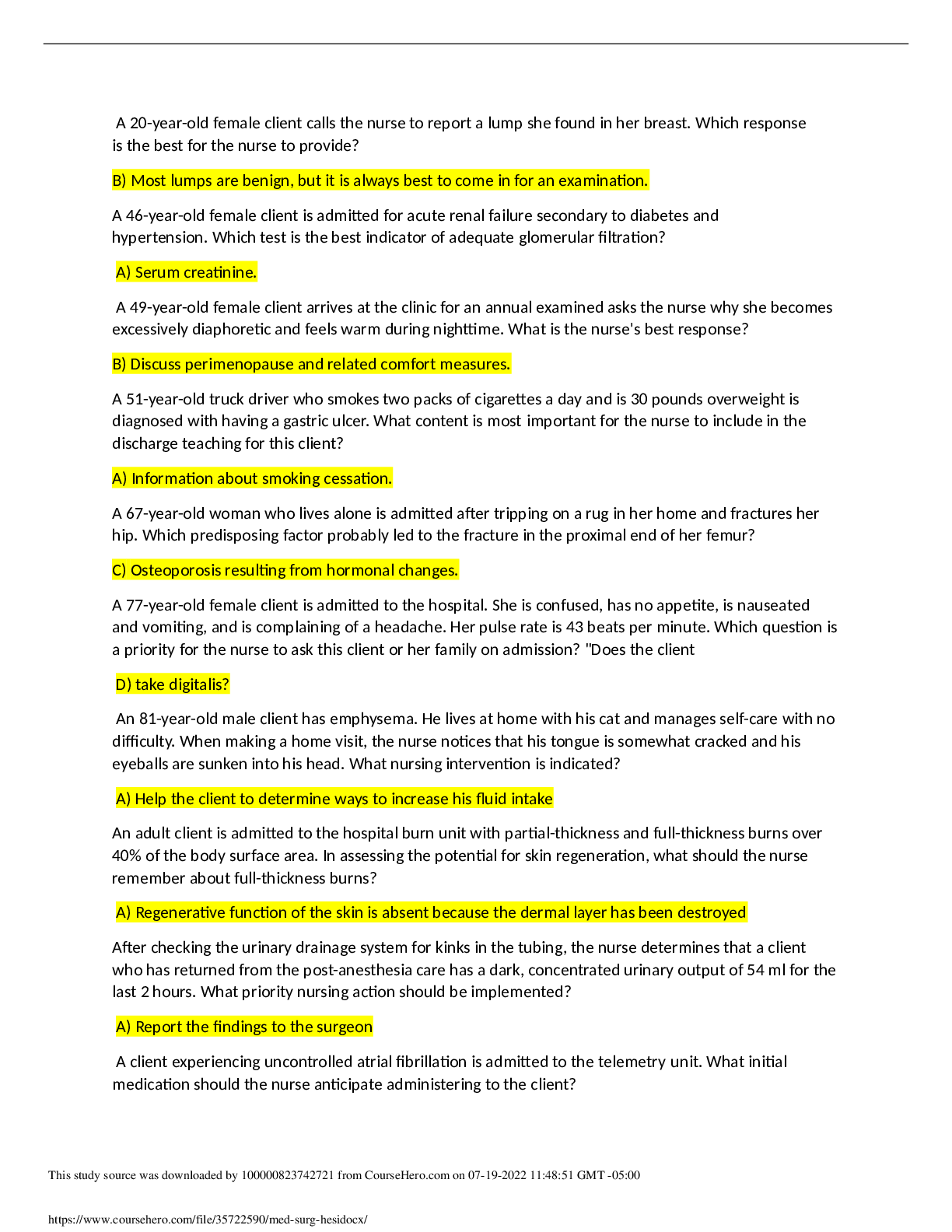
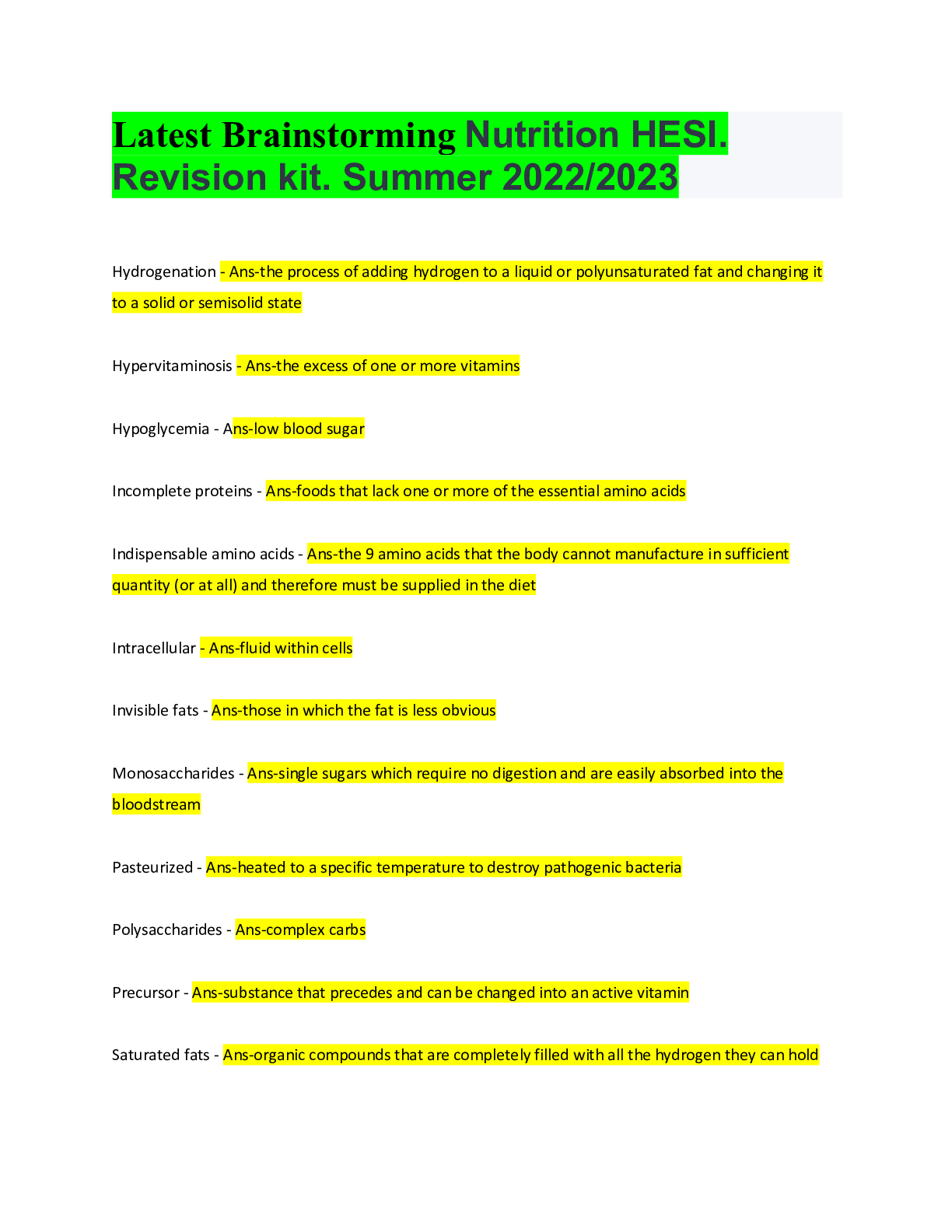
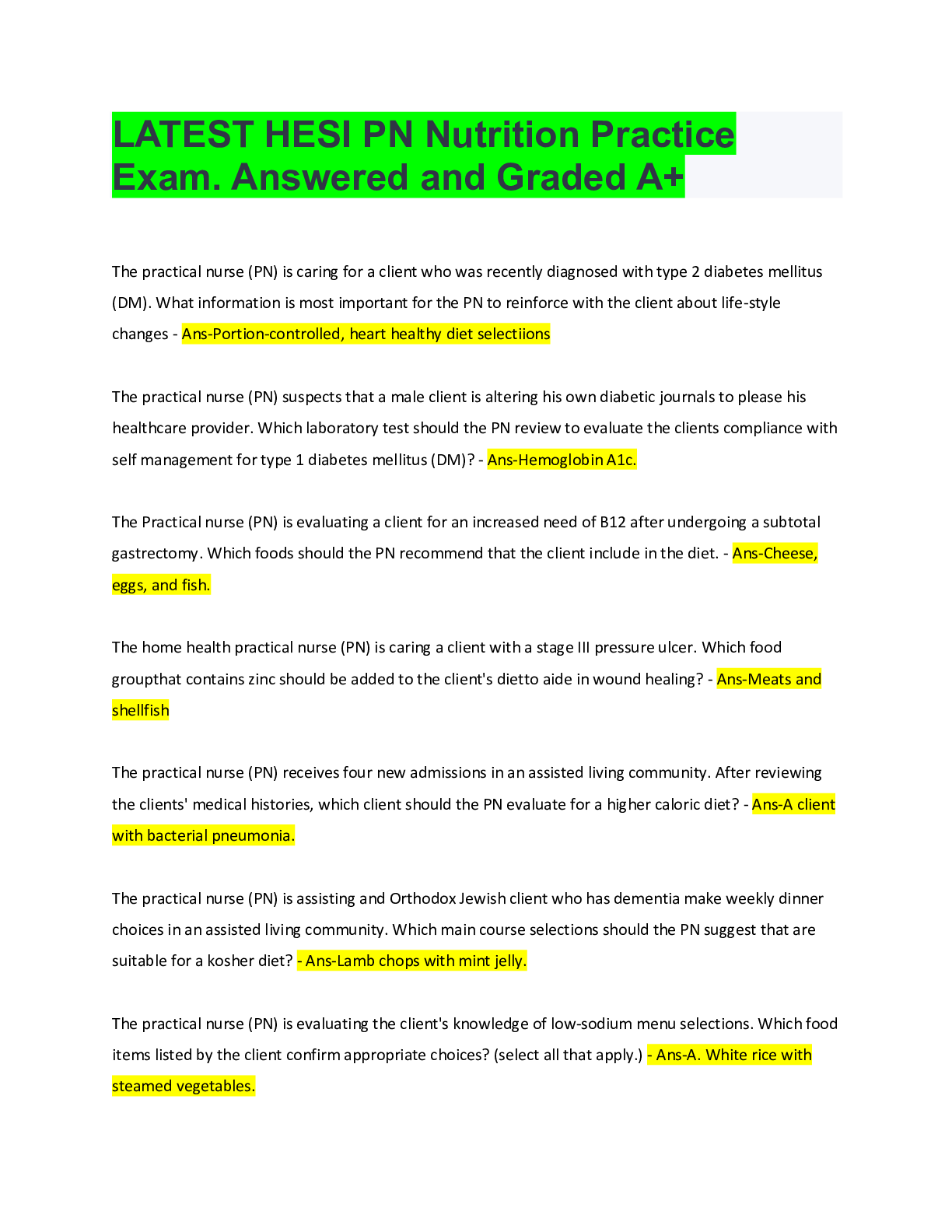
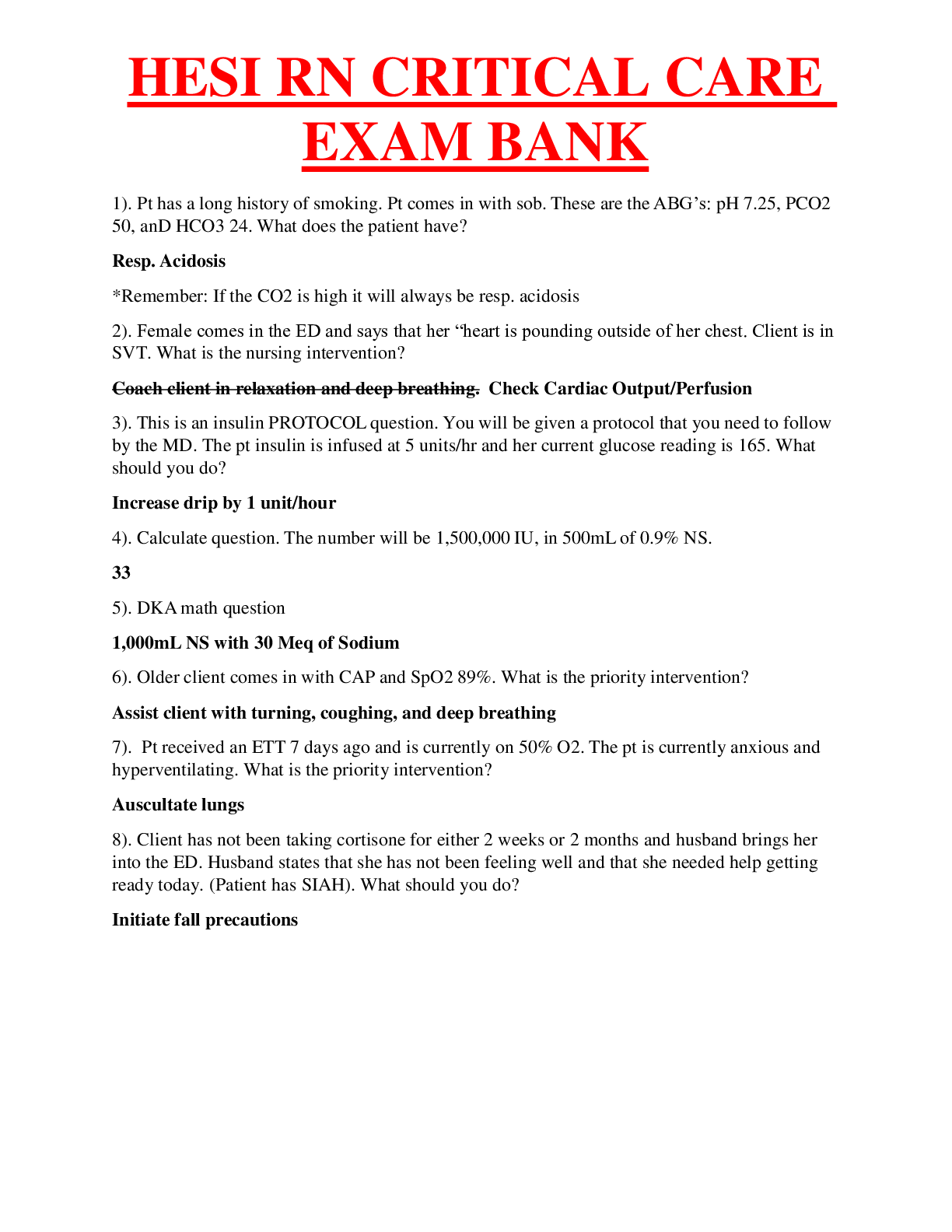

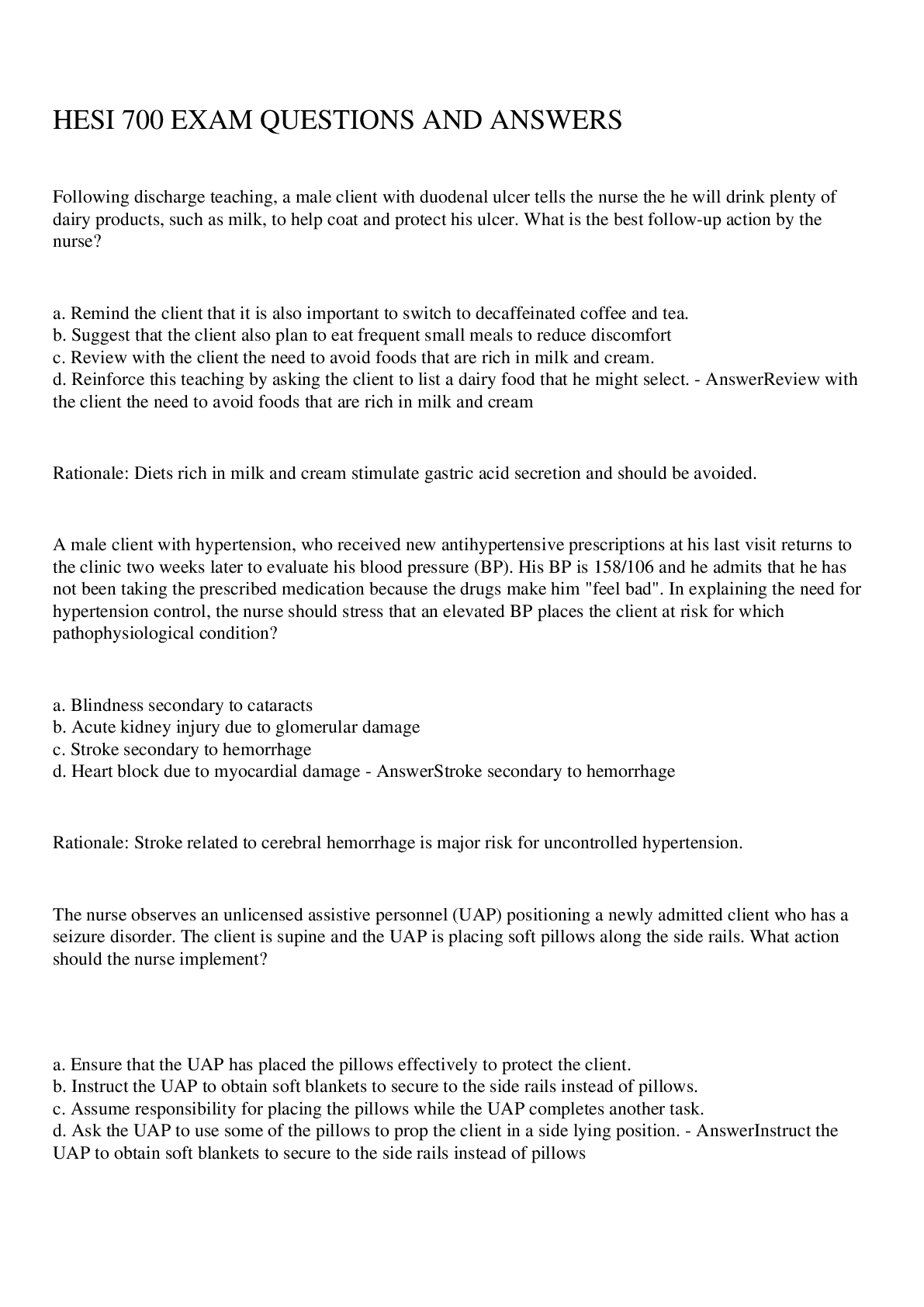
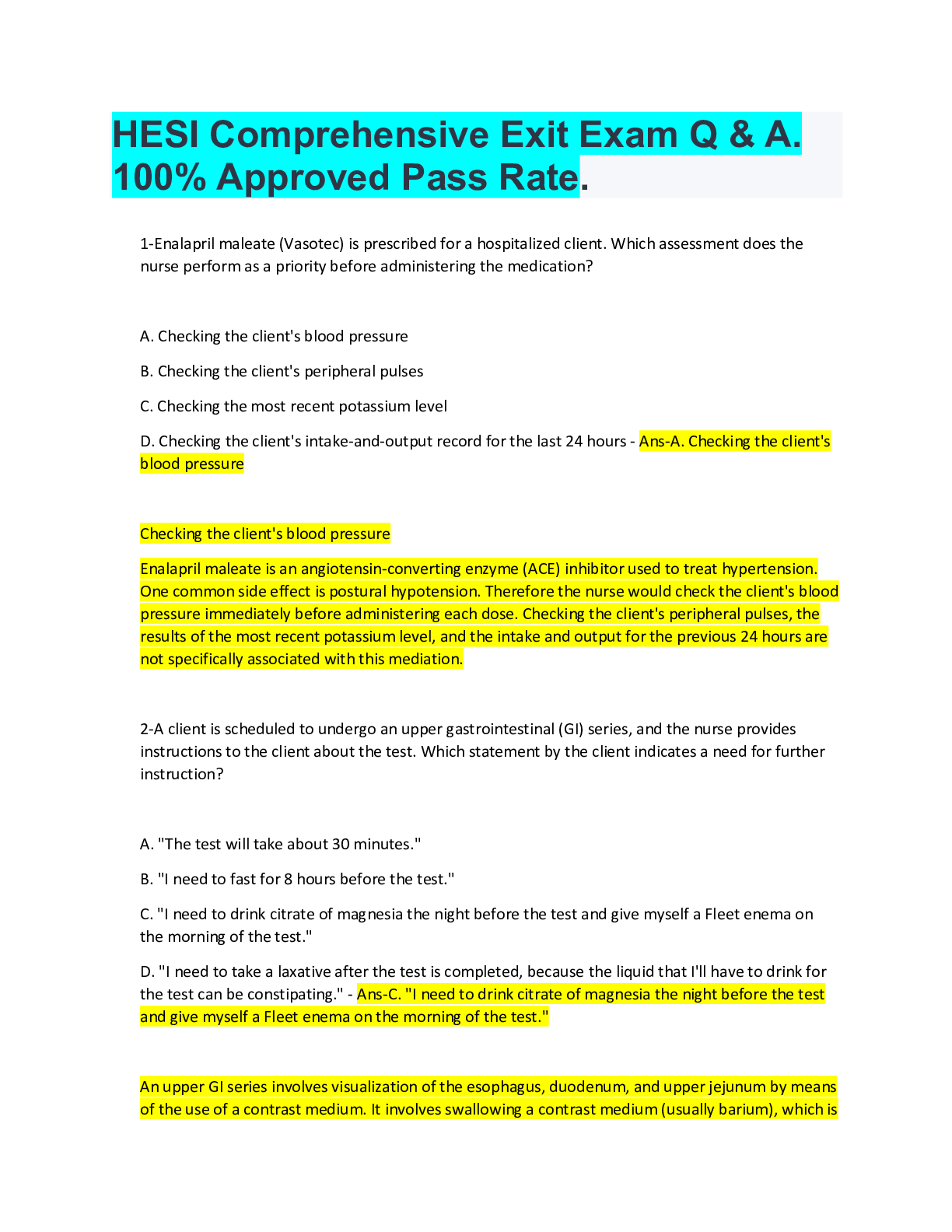
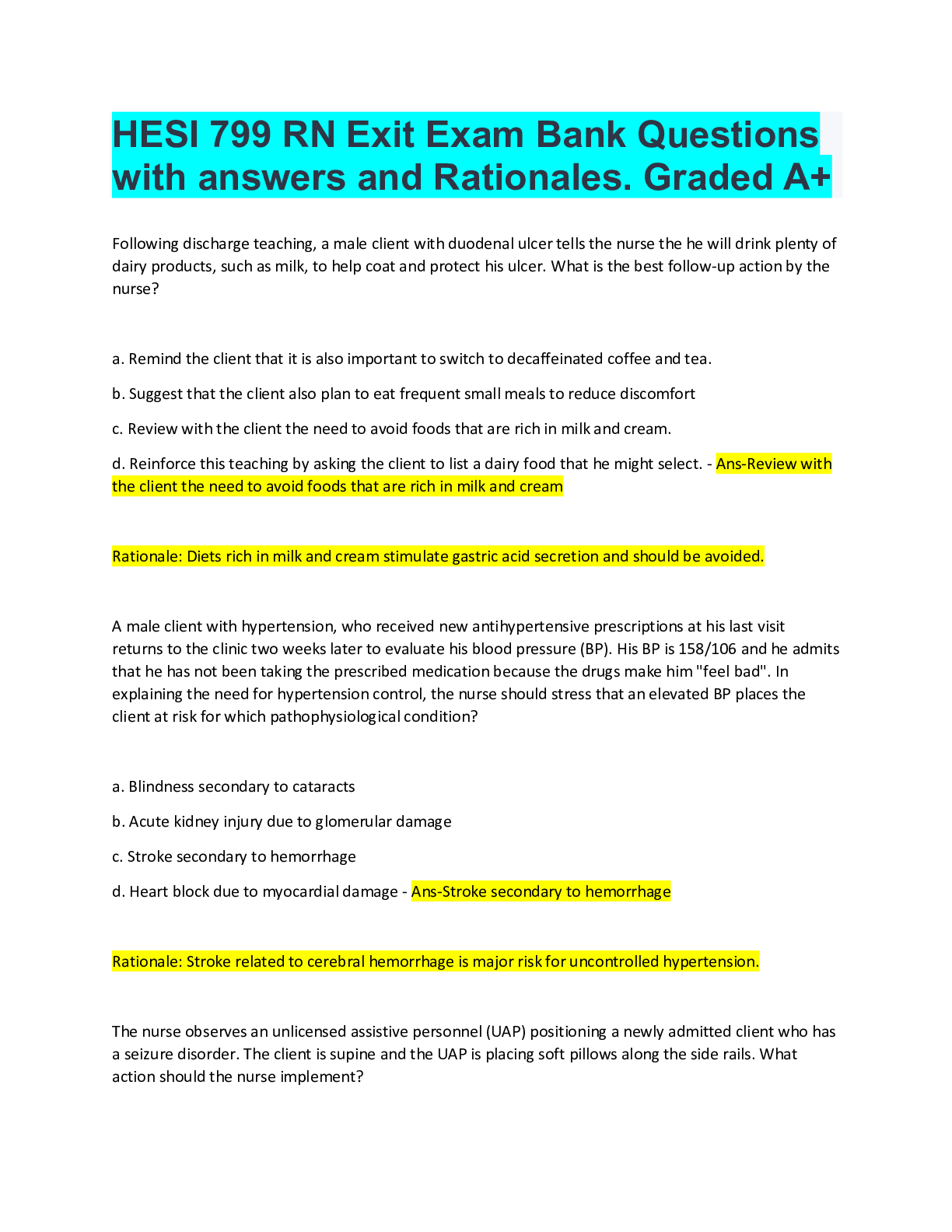

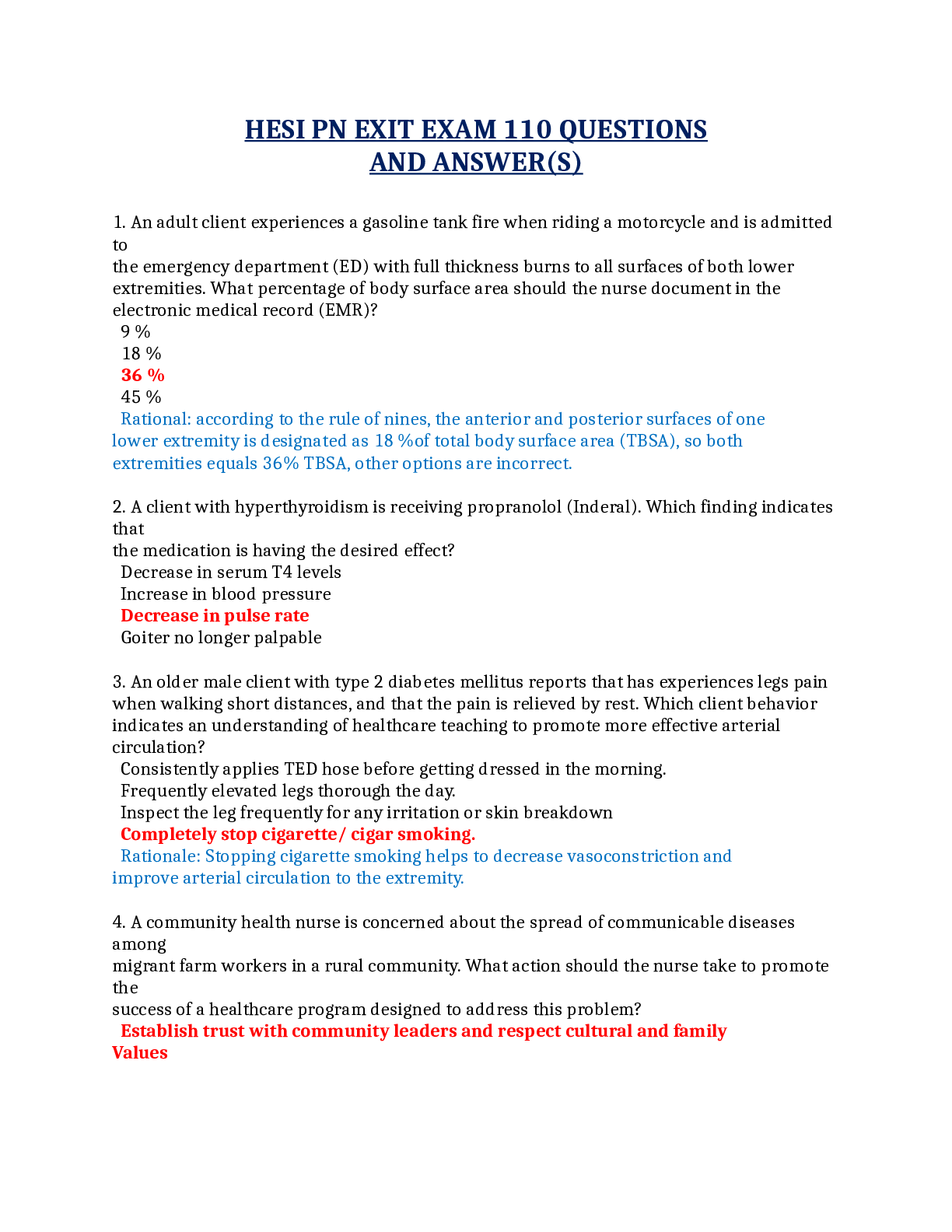
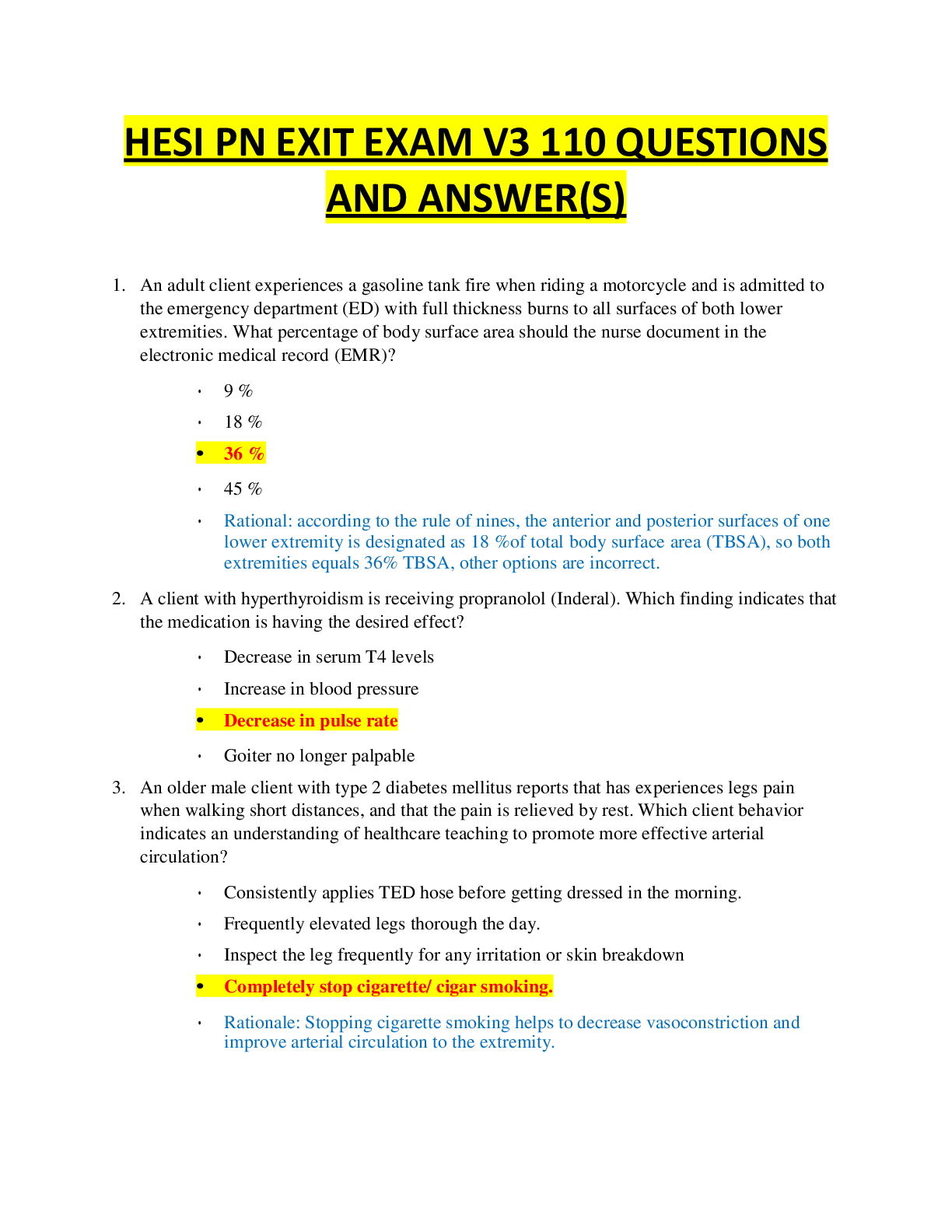
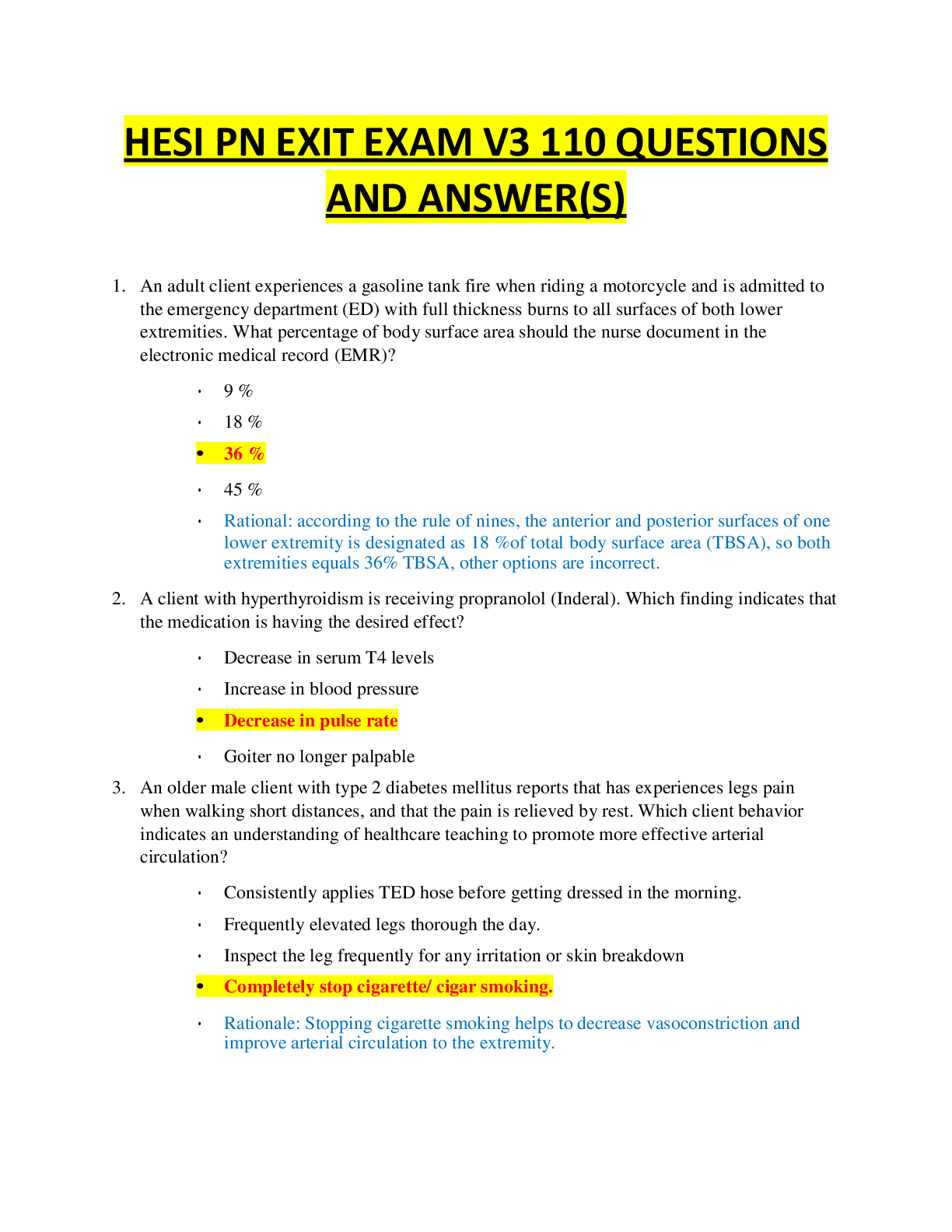
 100 QUESTIONS AND ANSWER(S) WITH RATIONALE TEST PREP GUIDE GRADED A+.png)
